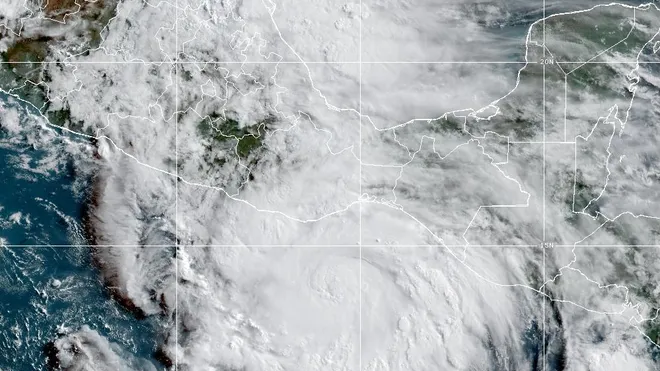Hurricane Erick, a powerful and destructive hurricane, hit the Mexican Pacific coast on Thursday. The United States National Hurricane Center confirmed that Erick hit the western region of Oaxaca state in the early hours of the day. Erick was a 205km/h (125 mph) wind when it struck. Being still in Category 3, although it was downgraded earlier in the day to Category 4, it was extremely potent and able to produce significant damage.
Warnings for Dangerous Weather
Weather officials cautioned that Erick would cause destructive winds and an exceedingly heavy rainfall. These conditions give away to flash flooding, mudslides, and harmful seas. It is supposed to hit the states of Oaxaca and surrounding Guerrero the hardest. The government has been calling on the population to stay inside and tune into emergency services both on the local and national level.
A powerful message was broadcasted by Mexican President Claudia Sheinbaum. She called people living in the areas of the storm to pay attention to it and not to go outside. She also suggested that people should relocate to shelters already prepared to withstand this emergency especially in river banks or low-lying areas.
Large Evacuation and Emergency Response
In guarding lives, there are approximately 2,000 emergency shelters established in the states of Chiapas, Guerrero and Oaxaca in Mexico. More than 18,000 first responders and emergency workers have been deployed to aid in rescue relief, and safety efforts.
The communities facing these regions are often small and situated in mountains or the coastline line thus becoming particularly susceptible. Residents living in elevated places are equally advised to look out for mudslides, which are common when excessive rainwater is released on hilly terrains.
Past Storms Add to Worries
The fear around Hurricane Erick is especially strong because of a recent memory—Hurricane Otis. In 2023, Otis struck the same region, hitting Acapulco as a Category 5 storm. It killed at least 50 people and caused massive destruction. What made Otis so deadly was how quickly it intensified. Many people had little time to prepare.
This time, officials are trying to act early to avoid the same outcome. The public has been reminded of the past and asked to take the warnings seriously. The goal is to save lives and prevent loss before it’s too late.
A 500-Kilometer Danger Zone
A hurricane warning has been declared for a 500-kilometer stretch of Mexico’s Pacific coast. This area runs from Acapulco, a popular beach town, to Puerto Ángel. It includes dozens of towns and fishing villages that could be affected by strong winds and flooding. Coastal areas are also at risk of powerful waves and sea surges.
Tourists and locals have been asked to stay away from beaches and not attempt to travel during the storm. Airports, buses, and many businesses have shut down or changed their schedules due to the dangerous weather.
Rapid Weakening Expected
Though Hurricane Erick was powerful when it arrived, forecasters say it will weaken quickly once it moves inland. The mountains of southern Mexico usually reduce the strength of hurricanes soon after landfall. However, the heavy rain that follows can still cause landslides, road damage, and power outages. Emergency services are preparing to help with rescue operations and deliver supplies if roads become blocked or homes are damaged.
Conclusion
Hurricane Erick has brought strong winds, heavy rain, and serious danger to Mexico’s Pacific coast. With memories of Hurricane Otis still fresh, the country has moved quickly to warn people and offer shelter. Thousands of emergency workers are standing by, and communities are bracing for the storm’s full impact. The next few days will be critical in making sure lives are saved and damage is limited. As Erick moves inland, the focus will shift to recovery and rebuilding.








